Antimatter, the mirror world (Particle Physics Series – Episode 4A)
Let’s take the red pill together and travel across the mirror, unraveling the mysteries of Antimatter.
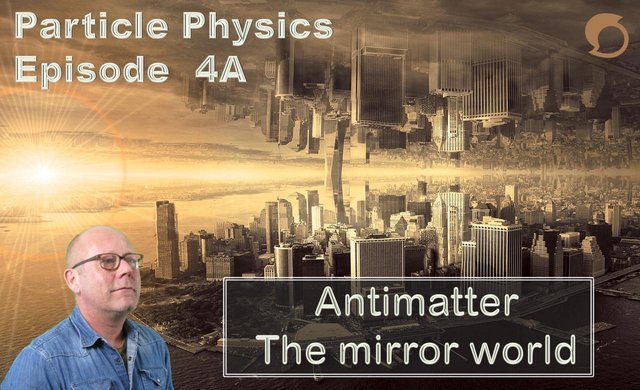
Since the first episode of this series, we have been visiting the fascinating world of small scale physics as we know it today. We have met many of the elementary particles described by the standard model as well as some of the interactions between them.
Yet, there’s more, much more, at least twice as more!
Every matter particles has a twin brother identical in some ways and opposite in others: its anti-particle. For example, the up and down quarks have anti particles called anti-up and anti-down quarks. Combined, these can form anti-protons. Electrons have anti-particles called anti-electrons (or positrons). Combine a positron and an anti-proton and you get an anti-hydrogen atom.

Anti-particles, like the positron, have been observed in nature and can even be created artificially. Anti-hydrogen atoms have not been observed in nature but can be fabricated in the lab using particle accelerators, although in extremely minute quantities. Anecdotally, anti-hydrogen must be one of the most expensive materials ever: count a production cost of about 60 trillion dollars per gram. That’s a lot of Steem ;-)!
When you think about it, antimatter is quite a weird concept, yet it is there, an integral part of our universe. Its study reveals many mysteries yet to be solved. This is a good thing: scientist love puzzles, because these allow them to move forward in understanding the intricacies of our universe.
Join me in meeting this fascinating family of particles.

Preliminary Notes
In order to fully appreciate the content of this article, especially if you are new to particle physics, I invite you to review some of the basics.
If you wish to dig in fast in this fascinating world, you can read a summary about what you need to know in the appendix of the article ‘Let Quarks be free’. Open the article in a new tab, and then go straight at the end of the article to the appendices (Appendix 1: elementary particles and Appendix 2: building protons and neutrons out of quarks).
If you wish to really catch the train and get a solid understanding of matter before meeting its little brother, antimatter, feel free to consult the previous episodes of this series:
- Elementary particles, the building block of reality (Particle Physics Series – Episode 1)
- Composite particles: let’s play Lego! (Particle Physics Series – Episode 2)
- Elementary fermions: the particles of matter… (Particle Physics Series – Episode 3A)
- Where does the mass of hadrons come from? (Particle Physics Series – Episode 3B)
- Let quarks be free! (Particle Physics Series – Episode 3C)

1/ Table of contents
There is so many fascinating aspects of antimatter to discuss that this subject will actually be presented as a mini-series of 5 episodes, maybe more.
- Episode 1 (This one): How antimatter was discovered. Description of antiparticles and composite anti-particles.
- Episode 2: Interaction of matter and anti-matter (pair production and annihilation). Meeting an anti-you and destroying the world. The birth of matter and antimatter in the universe.
- Episode 3: Matter/antimatter asymmetry and The CPT theorem.
- Episode 4: Detecting antimatter in our universe. Are there anti-planets, anti-stars and anti-galaxies?
- Episode 5: Could we be the neighbors of an antimatter universe? (Context: multiverse of level 1).
As you can see, that’s cool stuff that is cooking for you my dear science savvy Steemians!
Now, let's dive in!

2/ A brief history of antimatter …
The existence of a mirror world was first imagined by Schuster in a letter to Nature in 1898. He didn’t have any formalism to mathematically describe this crazy idea for the times. A few decades later, after much theoretical progress in Physics had been made (Einstein’s relativity, quantum mechanics ), the antimatter world naturally appeared in equations.
Let’s see how.
Erwin Schrodinger had just developed his famous equation describing the weird behavior of quantum mechanics taking as frame Newton’s classical mechanics. At the time, Einstein’s special relativity was starting to be wildly accepted by the scientific community. It therefore felt like the next step to re-write Schrodinger’s equation within the frame of special relativity.
It is Paul Dirac that was able to reformulate Schrodinger’s equation within that frame. To his surprise, when applying this formalism to the quantum behavior of the electron, he realized that to each solution of positive energy corresponded a solution of negative energy (Think about solving x2 = 4, there are two solutions: +2 and -2). This result implied the existence of a symmetric particle, the positron…

It was in 1932 that Carl Anderson made the first observation of a positively charged electron in radiation coming from the sky (cosmic rays). It was found that such particles would annihilate into gamma photons when in contact with matter. It didn’t take long before those particles were produced artificially by bombarding matter with high energy gamma rays.
About 20 years later, in the years 1955 and 1956, the anti-proton and the anti-neutron were observed.
Today, we know that there is a mirror version to all particles.

3/ What is Antimatter?
To all particles of matter is associated a particle of antimatter. We will start our exploration by comparing a particle and its antiparticle.
Let’s consider the up quark. We have seen previously that this particle, involved in the formation of the neutron and the proton, carries an electric charge Q of +2/3 (of the elementary charge e) and a baryon number B of +1/3. It also has a mass and a spin.
Its anti-particle, the anti-up quark has an opposite charge and an opposite baryon number (Q = - 2/3 and B = - 1/3). On the other hand, spin and mass stay the same. Same story with anti-down quark (Q = +1/3 and B = - 1/3).
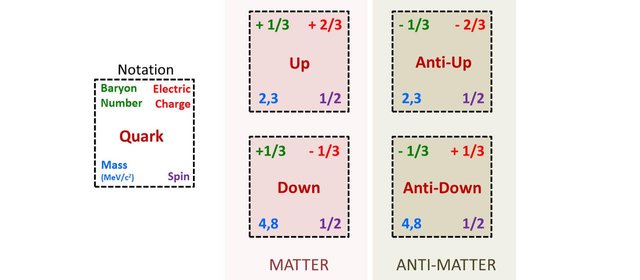
The principle is the same for leptons. The electron has an electric charge Q = - 1 and a lepton number (L) of +1. Its antimatter counterpart, the positron (or anti-electron) has a charge and baryon number of same magnitude but of opposite sign: Q = + 1 and L = - 1. As for quarks and anti-quarks, mass and spin stay the same when passing from lepton to anti-lepton. This principle applies for all elementary fermions.
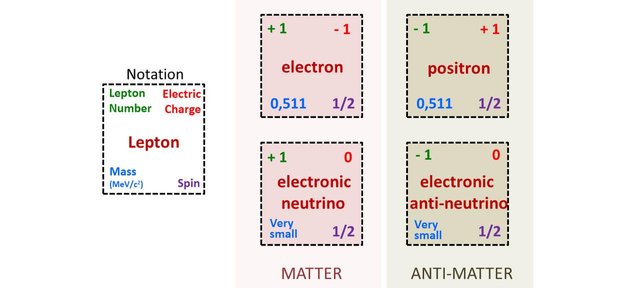
The standard notation that you will encounter in most publications and books about antimatter consists in putting a bar above the letter representing the particle (with an exception for the anti-electron, the anti-muon and the anti-tau where the sign of the electric charge is indicated).
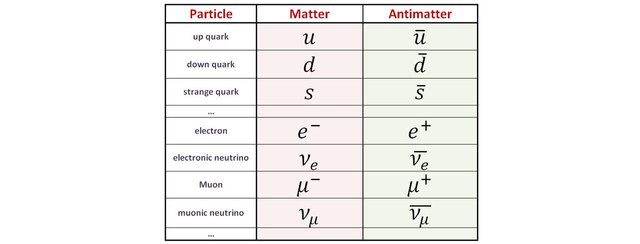
For bosons, it is a little more complicated. Some are their own antiparticles (the photon, the Z0 boson), while others, because charged in respect to their role in a fundamental force, have antiparticles associated to them (the W- is the antiparticle of the W+, an “anti-X-colored” gluon is the anti-particle of the “X-colored” gluon).

4/ Elementary antimatter particles are also lego brick!
Is it possible to build up composite particles with antimatter? Yes, absolutely. Apart from having some quantum numbers of opposite sign, they do behave like matter particle, thus can be subjected to the same interactions and build up composite particles the same way.
For example, an anti-proton is composed of two anti-up quarks and one anti-down quarks (uud). The charge of the anti-proton is therefore Q = - 2/3 - 2/3 +1/3 = -1. Its baryon number is B = - 1/3 -1 /3 -1/3 = -1, so it is also an anti-baryon.

Try it for the neutron (udd), you will see that an anti-neutron ends up also as an anti-baryon (B = -1) of charge Q = 0.
Feel free to dive into the details of antimatter particles by visualizing the video I made for my students:
So, we have seen that anti-nucleons like the anti-proton and the anti-neutron can be built out of anti-quarks. What about anti-atoms? Well, it works also...
By letting an anti-proton meet an anti-electron, one gets an anti-hydrogen atom. In 1995, the first anti-hydrogen atoms were artificially created with much effort at CERN. Today, it is still not a routine operation, but anti-hydrogen atoms can be produced and most importantly, can be contained for more than a quarter of an hour, long enough to study their properties in detail.
It was confirmed that anti-hydrogen atoms behave exactly like normal atoms: anti-hydrogen atoms exhibit the same emission spectra than hydrogen atoms. That means that anti-hydrogen atoms exhibit the same energy levels than normal hydrogen does. For more details about atomic spectra, consult the video series on atomic physics I published a few months ago on Steemit.
The fact that anti-atoms behave like atoms can make the imagination go wild… Could anti-planets, anti-stars or even anti-galaxy exist somewhere in the distant universe? Stay tuned, because we will discuss this fascinating idea in a further episode of this series!
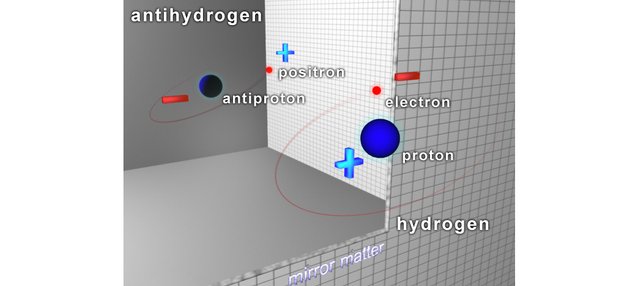

The 'Particle Physics' series is aimed at providing an introduction to the world of small scale physics to non-scientists and high school students preparing for their high school exams.
Previous episodes:
- Elementary particles, the building block of reality (Particle Physics Series – Episode 1)
- Composite particles: let’s play Lego! (Particle Physics Series – Episode 2)
- Elementary fermions: the particles of matter… (Particle Physics Series – Episode 3A)
- Where does the mass of hadrons come from? (Particle Physics Series – Episode 3B)
- Let quarks be free! (Particle Physics Series – Episode 3C)
Can't wait to know more?
If you can't wait to dive deep into the antimatter world, there are already some excellent articles on Steemit written by a professional particle physicist, @lemouth.
- Live from CERN - What does antimatter say when it falls?
- Live from CERN - Measuring antimatter properties with hybrid matter/antimatter atoms (without destroying the world)
- Live from CERN - ELENA is so beautiful that antimatter gets slow
- Antimatter strikes back: the CPT symmetry and the revenge of the antiproton magnetic moment at BASE (CERN)

Sources, references and to dig deeper:
- https://en.wikipedia.org/wiki/Antihydrogen
- https://en.wikipedia.org/wiki/Antimatter
- Small scale Physics - Part 1 (booklet I wrote for my students)
- Book: Physics for the IB diploma (K.A. Tsokos, Cambridge edition)
- Book: L’anti-matiere (Gabriel Chardin)
Image credits:
- Portraits of Dirac and Schrodinger by the Nobel Foundation (via wikimedia commons) (link Dirac, link Schrodinger).
- Portrait of Einstein by Orren Jack Turner, and modified with Photoshop by PM_Poon and later by Dantadd (via wikimedia commons) (link Einstein).
- Portrait of Carl Anderson by the Smithsonian Institute (link)
- Image of the hydorgen lookign at its anti-hydrogene counterpart in the mirror by NSF (link)
- All other pictures and visual elements are free for use commercially and were found either on Pixabay
- All illustrations, diagrams and friezes put together by @muphy.
- Video and music on video produced by @muphy.

Hi,
I’m @muphy (see intro post),
My life revolves around music production, teaching sciences, and discovery through travel.
You enjoyed that post? Resteem and Upvote!
You are interested in these topics? Follow me!
Being A SteemStem Member
Great post! For this time, I have only one remark (about neutrinos) and one more historical comment (Klein and Gordon) which may be useful to include in the text.
You are missing the Klein-Gordon equation, from 1926. Dirac equation came 2 years later. One of the problems with the Klein Gordon equation was that there were solutions with a negative energy, i.e. the antiparticles (a problem at that time). Dirac tried to get rid of them, but failed ;)
At the end of the day, those solutions were really there and antimatter was born. Okay, in fact, the right interpretation appeared later, in the 1940s.
Actually, lepton number does not have to be conserved, and neutrinos could be their own antiparticle (they are, in most models trying to explain neutrino masses). For instance, in the Standard Model, the neutrino mass term arises from the so-called 'Weinberg operator' that violates lepton number conservation by two units.
Thank you very much for the historical comment. I didn't know that. It is amazing how history "forgets" some of its contributors. there is a quite a probability for example that in a century or so, everyone will know about Higgs, yet many will have forgotten Englert and Brout...
Yes, if neutrinos are found to be majorama particles (if neutrinoless double Beta decays are finally experimentally confirmed), the Lepton number would be violated... I wonder how I should take it if this occurs ;-) It will just make particle physics more complicate to me lol!
Klein and Gordon are not really forgotten. Klein Gordon equation is in general taught before Dirac equation (it describes after all the dynamics of the Higgs boson) :)
For this reason, strictly speaking we must discuss the Higgs boson but the Brout-Englert-Higgs mechanism. Many of us are trying to stick to that in order to have justice for everyone.
For the specialist maybe, but I believe the profane knows the name of Dirac, yet Klein and Gordon might not be so recognized (for example, I didn't know them, I thought Dirac had done all the work).
Yet, I agree with you, recognition should be fairly spread out. I will attempt to mention more often the names of Englert and Brout when the Higgs Boson invites itself in my posts...
I will not change the name of my cat though. Her name is Higgsy ;-)
You thus want a clean Higgs :D
She also is very sociable, and interacts a lot with any human visiting me. Then, it requires a stronger effort from their part to leave. it's like if my cat was giving them extra mass...
Hey, maybe she's the extra Higgs Boson they are looking for at CERN, hiding in my sink, so not to be found
:-)
Higgs cascades! (the topic of one of my latest article, where heavy Higgses can be produced and then decays into lighter Higgses that themselves decay into the Standard Model Higgs) ^^
Another Great post! I have not checked but have you done a post on dark matter?
Cheers Larry :-)
Not yet, and I have quite a few series to complete before I explore the realm of dark matter. I will probably talk about it in the future when I write a cosmology series.
In the meantime, I noticed a post from @lemouth that just came out a few hours ago... I haven't looked at it yet, and it looks quite interesting. You could check it out. https://steemit.com/steemstem/@lemouth/dark-matter-versus-neutron-stars-round-1
Be well
Thanks for the advertisement (also in your post) :)
Thank you for sharing @muphy! I will be looking forward to those posts in the future.
I actually wrote a lot about dark matter for a year, as this consists in a large part of my present research work.
@lemouth what are the odds I would ask that question around the same time you would post such a topic. I could have swore I was following you, I am now for sure. Checking out that post, as I have a few questions concerning the discernment between the "matters". Thanks!!
Feel free to post any question! I will be more than happy to answer them ^^
Well. I have had no much interest in nuclear physics. As a student of electrical/electronic engineering, I see interest only in digitization and the likes.
However, I have picked interest with your posts.
With the discovery of atomic bombs, anti-particles may have neutralizing effect if deeply studied which would save the world from ravage of nuclear weapons
It feels rely good when my words trigger a new interest in a reader. Thank you for comment.
Unfortunately, antimatter is not a neutralizing agent to the deflagration of Atomic bombs. On the contrary as you will see in my the episode of this series, the destructive potential of antimatter can make atomic bombs look like these small bangers children play with...
Yet, producing and containing antimatter is so difficult and expensive that thankfully the risk of an antimatter bomb seeing day of light is infinitely close to zero.
Thanks. Waiting for more
I really liked this post. Just wanted to apologize for the small vote, I am trying to recover my vp :(
No worries man, the most important is that you enjoyed reading it :-)
my mind is literally blown away right now something very different this was dammn :D
Wait until you see the next post (Episode 2), that will blow you away, literally haha.
It will be about the power of the explosion when matter and antimatter meet. I did the calculations, it is truly amazing!
Wow!
This is educative. I agree with you on the following;
And
I must commend you for bringing forth this article. Great job @muphy . Looking forward to read more physics posts from you.
Thank you for your kind comment. I am pleased this article interested you.
Wery good can do activity in steemit. That's a lot to do. Good for learning or adding insight. Thank you very much.
Cheers Lingi. Glad you liked it.
Buen post! muy educativo, Gracias por compartir.
Gracias, estoy feliz de que lo hayas disfrutado :-)
A Physics lesson on steemit. We are learning and earning on steemit.that is very good.
Steemit is an incredible place to learn new things, I agree!